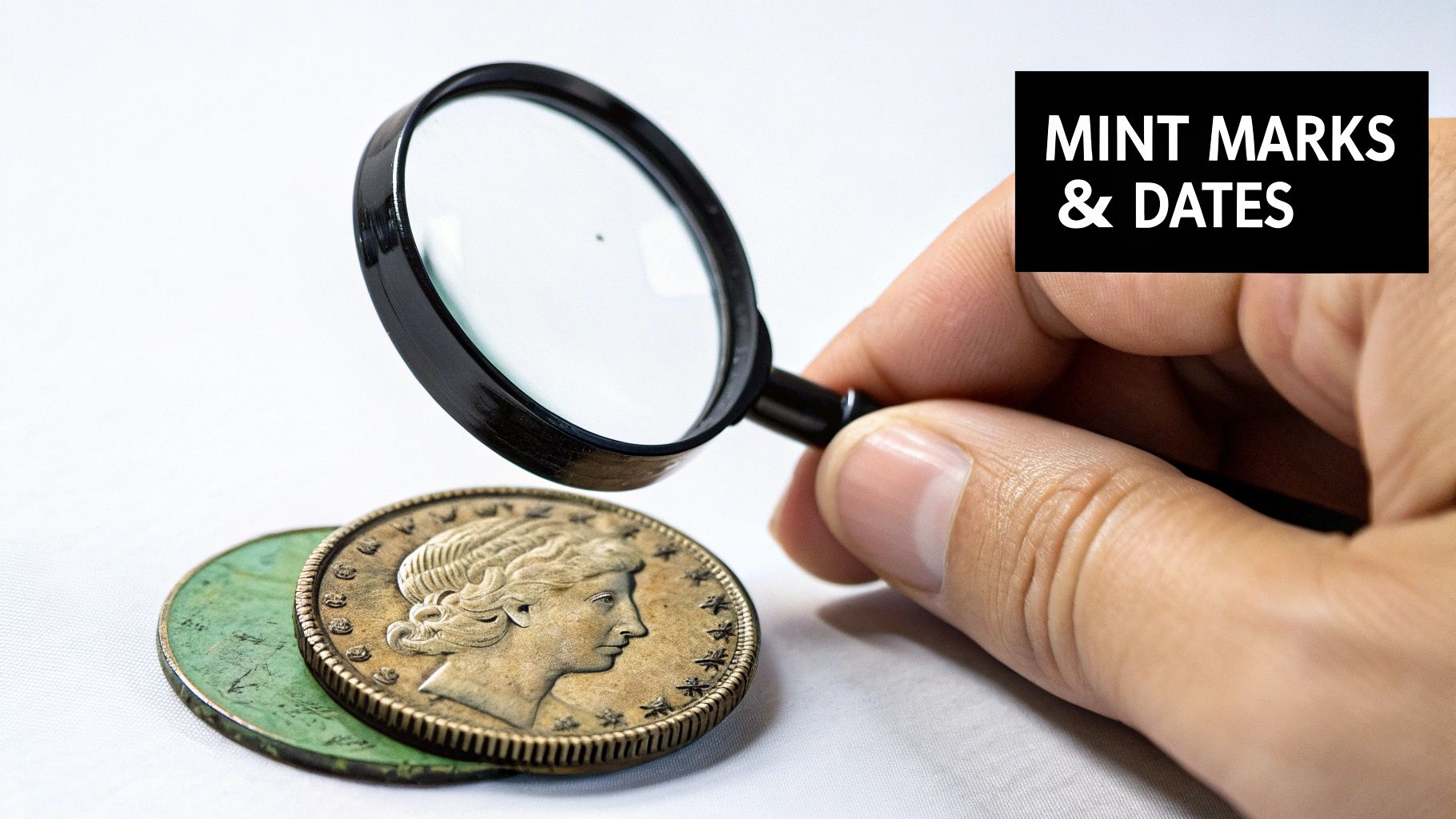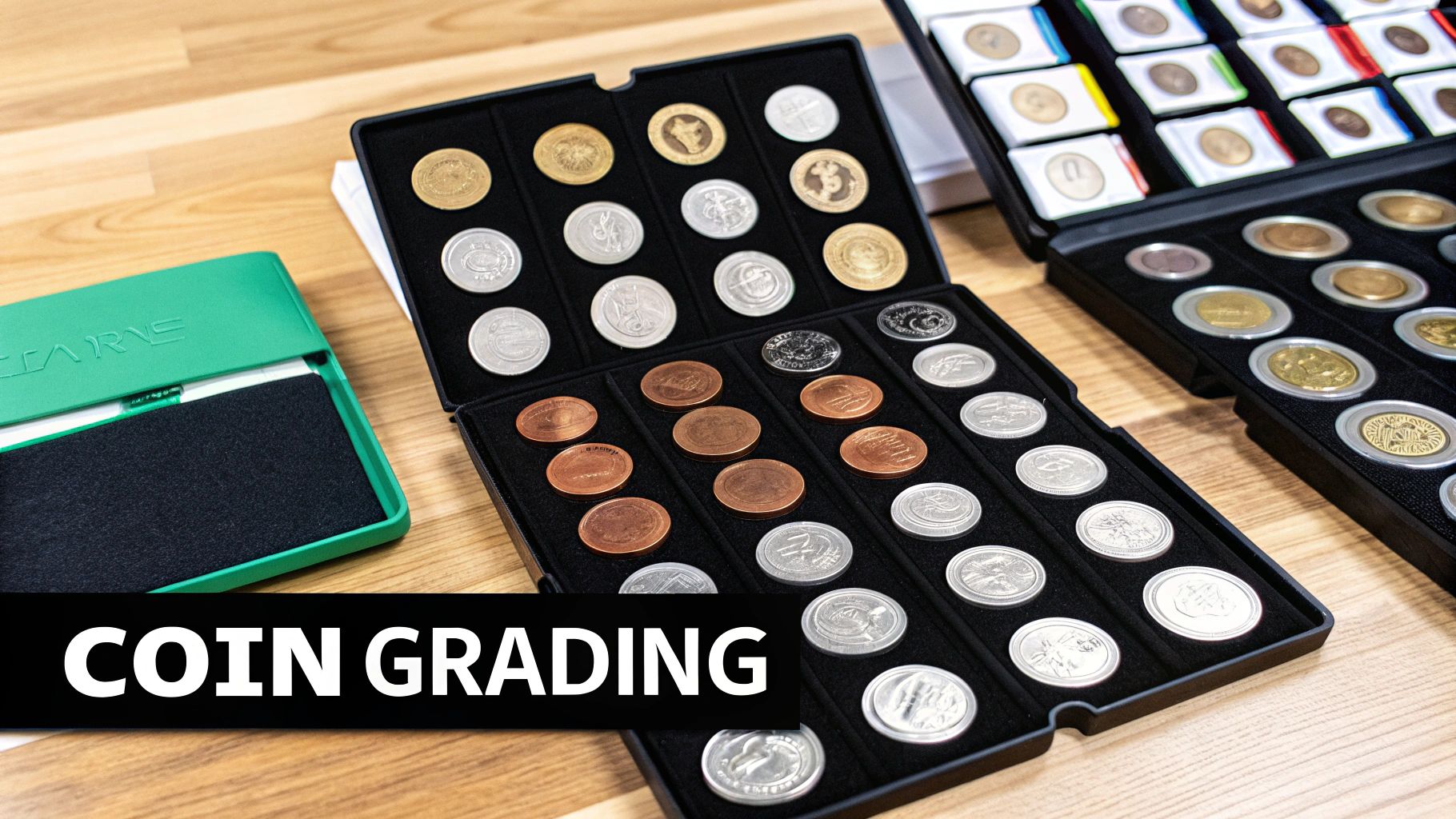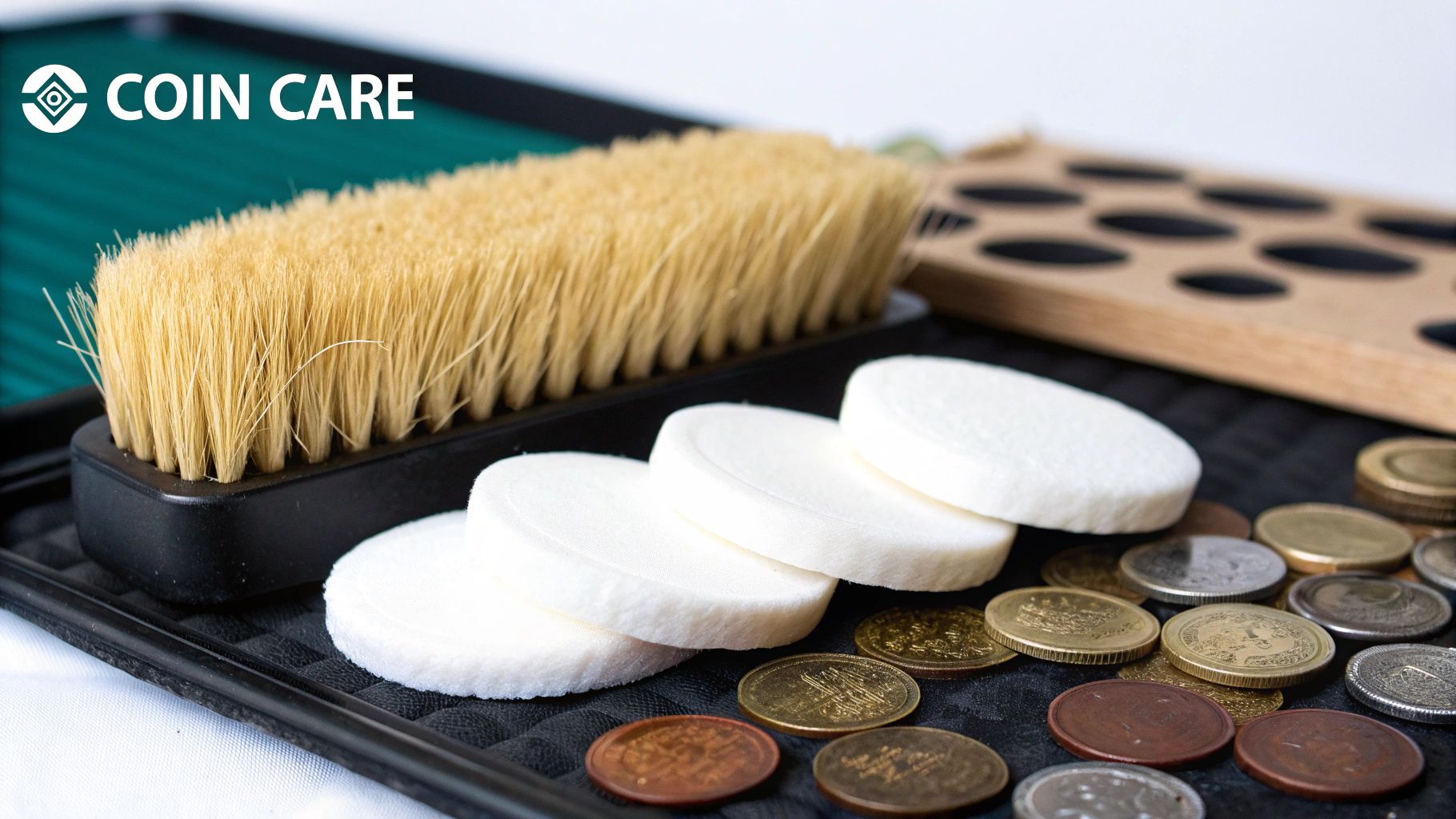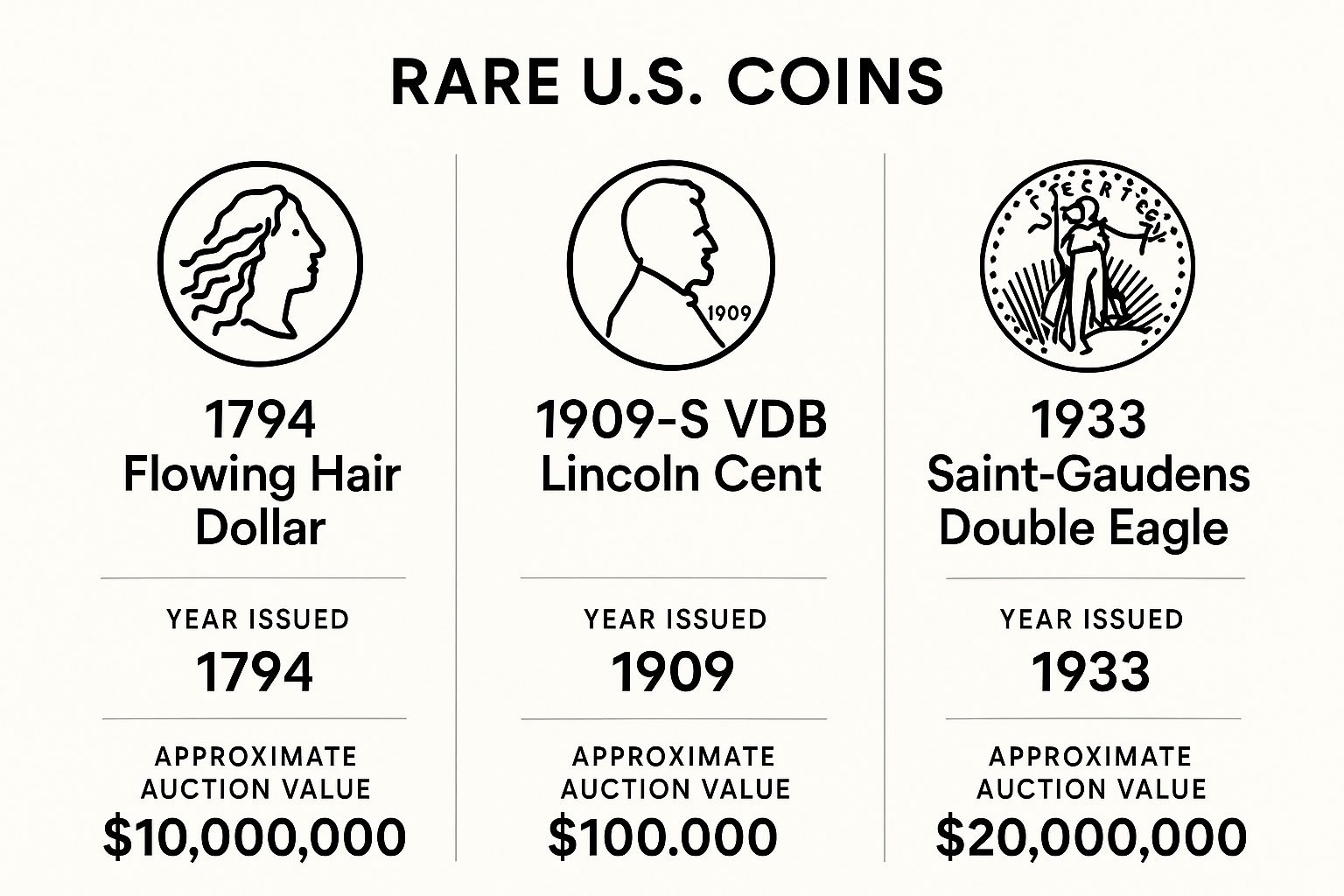So, you've got an old coin in your hand. That little piece of metal is a direct connection to the past, and the first, most crucial step is to get to know it up close. Forget about its value for a moment. Right now, it's all about a careful, methodical inspection to build a profile of your coin.
This first look is where you gather your initial clues—the date, any visible words, and its overall condition. All you need are your eyes and a few simple tools. This is how an unknown object starts its journey to becoming a properly identified artefact.
Your First Look at an Old Coin

Before you dive into online catalogues or price guides, take a moment. The information you gather now will be the foundation for all your research. Think of yourself as a detective, and the coin is your primary piece of evidence.
Handle With Care
Rule number one: do no harm. Over decades, a coin develops a natural surface layer, or patina. This is a huge part of its history and, for most collectors, its character. If you try to clean it with polish or abrasive chemicals, you'll create microscopic scratches and strip away that history, potentially destroying its value.
My Two Cents: Never, ever use metal polishes or harsh cleaners. If a coin is caked in loose dirt, the absolute most you should do is give it a gentle rinse in distilled water and carefully pat it dry with a soft, lint-free cloth. For anything that seems potentially valuable, it's always best to leave it exactly as you found it.
When you do pick it up, always hold it by its edges. If you have them, a pair of soft cotton or nitrile gloves is ideal for preventing the oils from your skin from causing corrosion down the line.
Essential Tools for Observation
You don't need a fancy laboratory to get started. A few basic items are all it takes to uncover the details you need for identification.
- A Good Magnifying Glass: A jeweller's loupe with 5x to 10x magnification is perfect. It’ll help you decipher worn inscriptions, find tiny mint marks, and appreciate the finer details of the design.
- A Soft, Lint-Free Cloth: Not for cleaning, but for placing the coin on. This prevents you from accidentally scratching it on a hard table or desk.
- A Notebook or Digital Doc: You need a dedicated place to write down everything you see. Be systematic.
To help with that, here's a simple checklist I use. It forces you to look closely and record the key features before you get distracted by research.
Initial Coin Observation Checklist
Use this checklist to systematically record the key features of your coin during your initial inspection.
| Feature | Observation Notes (e.g., date, inscription text, portrait direction) | Condition (e.g., worn, clear, damaged) |
|---|---|---|
| Date | ||
| Denomination | ||
| Portrait/Main Image | ||
| Inscriptions/Text | ||
| Edge Detail | ||
| Mint Mark (if any) | ||
| Metal/Colour |
Filling this out gives you a concrete starting point. It’s much more effective than just trying to remember what you saw.
What to Look For
Your initial once-over is pure fact-finding. Note the obvious stuff first. Is there a date? Which monarch or historical figure is on the portrait? What do the words around the edge say?
The history of UK coinage is particularly deep, with the 1971 decimalisation creating a sharp divide between what we think of as modern and "old" money. With an estimated 30.1 billion coins in UK circulation back in 2016, even tiny differences in a date or design can be the key to identification. You can get a sense of the sheer scale by reading about the history of British coins and their circulation. This context helps you understand why every little detail you record is so important.
Decoding the Details of British Coinage

Once you've got the basics down, it’s time to get your hands dirty and really start identifying your old coins. This is where the real detective work begins, moving past the obvious dates and monarchs into the tiny details that can mean the difference between a common piece and a truly remarkable find. Believe me, the smallest features often tell the grandest stories.
A classic example, and one that’s easy to miss, is the mint mark. This is usually a tiny letter or symbol tucked away somewhere in the design, telling you which branch of the Royal Mint (or a contracted mint) actually struck the coin. A Victorian penny with a small "H" underneath the date, for instance, wasn't made in London but at the Heaton Mint in Birmingham. The presence, absence, or particular style of a mint mark can dramatically affect a coin’s rarity and, consequently, its value.
Don't forget to check the edge! It's amazing how many people forget a coin has three sides. Is it smooth? Does it have those vertical grooves (reeded)? Or perhaps it has an inscription? Many older, higher-value British coins have lettering around the edge. Small variations in this lettering can create incredibly rare and sought-after varieties.
A Case Study in Coin Evolution
Let’s look at the humble £1 coin for a perfect illustration of how these details come into play. For more than 30 years, the round pound was a familiar sight, with its distinctive yellow colour and designs celebrating the UK's four nations.
But to combat a rising tide of forgeries, the Royal Mint introduced a brand-new, 12-sided bimetallic £1 coin on 28 March 2017. This wasn’t just a cosmetic change; the new coin was packed with security features, making it one of the most secure pieces of currency on the planet. You can get the full story on this major transition from the Royal Mint’s official page.
This change highlights exactly why the small things matter so much. When identifying a modern pound coin, you're now looking for key differences:
- Shape: Is it the old round style or the new 12-sided one?
- Composition: Is it made from a single nickel-brass alloy, or is it bimetallic with a gold-coloured outer ring and a silver-coloured centre?
- Security Features: Does it have the new latent image (like a hologram) and micro-lettering?
Simply calling a coin "a pound" just doesn't cut it anymore. The specific design, shape, and year are all crucial for understanding its place in coinage history and properly assessing its authenticity and value to a collector.
Portraits and Symbols
Finally, take a closer look at the monarch's portrait on the obverse ("heads") and the symbols on the reverse ("tails"). The direction the monarch is facing, the specific style of their crown, and the arrangement of shields or national emblems are all vital clues.
These elements have changed countless times over the centuries. For anyone wanting to get a better feel for these shifts, exploring a brief history of British coins offers fantastic context. It's by mastering these nuances that you can begin to piece together the unique story behind every coin in your collection.
Researching Your Coin's History and Rarity

Now that you've given your coin a good look-over, it's time for the really exciting part: connecting those physical clues to the historical record. This is where a simple metal disc transforms into a real artefact with a story to tell.
Properly identifying old coins means knowing where to find trustworthy information, and the journey nearly always starts with a good reference book. If you're looking at British coins, a classic like Spink's Coins of England & the United Kingdom is an absolute must-have. These catalogues are packed with detailed listings, images, and vital data you can cross-reference with your notes. Think of them as the encyclopaedias of the coin world.
Of course, even the best book can't give you the latest market prices or what the community is talking about right now. That's where online resources really shine.
Tapping into Digital and Community Knowledge
Reputable online catalogues offer searchable databases that are always being updated. But don't just stop at static websites. Active numismatic forums and social media groups can be incredibly valuable. You can post clear pictures of your coin and get opinions from a whole community of collectors across the globe. It's amazing how often someone will spot a tiny detail or a rare variety you might have missed completely.
A quick bit of advice: When you ask for help online, give as much detail as you can. Always include the weight, diameter, and clear photos of both the front (obverse) and back (reverse). This helps people give you solid, accurate feedback instead of just taking a wild guess.
One of the most critical pieces of the puzzle is the coin’s mintage. This is the exact number of coins of that specific type and year that were ever produced. It’s simple, really: a low mintage often equals high rarity and value. For example, a coin with a mintage of only 50,000 will almost always be more valuable than one with a mintage of 50 million.
This data isn't just modern guesswork, either. The Royal Mint has a long history of tracking coin populations. Pilot surveys began way back in 1962 to figure out how many older pennies and sixpences were still being used. These projects grew into massive undertakings, counting over a million coins by 1967. This historical work provides a solid foundation for understanding which coins are genuinely scarce today. You can read up on the fascinating details of these early UK government coin surveys.
By mixing old-school book knowledge with today's digital tools and a bit of community help, you'll build a much clearer picture of your coin's history, rarity, and true significance.
Getting to Grips with a Coin’s Condition and Grade
Once you've done the historical legwork, it's time to get hands-on and assess the coin’s physical state. A coin's condition, which we call its grade, is almost always the biggest factor driving its value. It’s a classic numismatic truth: a very rare coin in terrible shape can be worth far less than a more common one that looks like it just left the mint. Learning to grade is a skill you simply have to develop.
This might sound a bit intimidating at first, but it really just comes down to looking for wear and tear in a systematic way. You don’t need to become a professional overnight; it’s all about training your eye. A great place to start is by examining the highest points of the coin’s design—think of the monarch’s cheekbone, the very top of a shield, or the most raised bits of lettering. These are the spots that take the first hit from being passed from hand to hand.
The image below gives you a sense of just how dramatically value can shoot up based on rarity and demand. But remember, a coin's grade is what truly unlocks that potential.

This chart is a fantastic illustration of the mind-boggling auction prices achieved by a few exceptionally rare coins. It really hammers home how history and scarcity combine to create numismatic legends.
Understanding UK Coin Grading Standards
In the UK, we use a fairly consistent scale to describe the level of wear a coin has seen, though you might see slight variations in terminology. Think of it as a spectrum, from heavily worn to absolutely perfect.
To help you differentiate between the grades you'll most often encounter with old British coins, here's a quick visual guide.
UK Coin Grading Standards Comparison
| Grade | Key Characteristics | Example Visual Clues |
|---|---|---|
| Poor (P) / Fair (F) | Heavily worn, barely identifiable. | Date might be gone or only partially visible. Main design is a silhouette. |
| Good (G) | Very worn, but main outlines are visible. | You can clearly read the date and key lettering, but the design is flat. |
| Very Good (VG) | Significant wear, but more detail than 'Good'. | Some internal details on shields or portraits start to appear. |
| Fine (F) | Clearly circulated, but all major details are present. | The highest points (hair, crown jewels) are worn smooth. |
| Very Fine (VF) | Light to moderate wear on the high points. | Much of the finer detail is still sharp. At least 50% of the original detail is visible. |
| Extremely Fine (EF) | Very light wear, visible only on the highest points. | The coin still has most of its original mint lustre. |
| Uncirculated (UNC) | No signs of wear from circulation at all. | Looks brand new, though it may have small nicks ('bag marks') from mint handling. |
Becoming familiar with these grades is the first step. You'll notice that the differences, especially between VF and EF, can be subtle but have a massive impact on value.
Of course, grading systems can differ, especially when you start looking at coins from the continent. For a closer look at how these standards compare, our guide on the European coin grading system explained offers some invaluable context, particularly if your collection spans beyond the UK.
The Perils of Cleaning a Coin
Here’s a word of warning. One of the most common—and heart-breaking—mistakes new collectors make is trying to ‘improve’ a coin by cleaning it. Taking a brush or chemical polish to an old coin doesn't restore it; it ruins it. This aggressive action creates thousands of tiny, unnatural scratches called hairlines all over the coin’s surface, and the damage is permanent.
A coin’s natural toning, or patina, is a part of its story and its authenticity. An improperly cleaned coin is almost always worth less than an untouched one in the same state of wear. Seasoned collectors value originality above absolutely everything else.
When you're examining a coin, keep an eye out for a dull, lifeless surface or fine, parallel scratches that catch the light, especially under magnification. These are the tell-tale signs of a clumsy past cleaning. A coin with its original surfaces, even if it's dark with age, is infinitely more desirable.
Verifying Authenticity and Spotting Fakes
In the world of numismatics, authenticity is everything. Getting good at spotting fakes is probably the single most important skill you can develop, as it’s your best defence against making a very costly mistake. The first step, really, is knowing what a fake coin even looks like.
Many forgeries can be unmasked simply by comparing them against the official mint specifications. A genuine coin was made to a precise weight, diameter, and thickness. Get yourself a good digital scale and a set of callipers to check your coin’s vitals. Even a tiny deviation from the official numbers is a massive red flag. For instance, a common trick is to use a cheaper base metal, which almost guarantees the weight will be off.
Common Signs of Counterfeit Coins
Beyond the basic measurements, counterfeiters often leave little clues behind. You just need to train your eye to catch them. Some of the most common red flags include:
- A "Soapy" or Soft Appearance: This is the classic sign of a cast coin. The details on the design—the lettering, the portrait—will look mushy and lack the crisp, sharp definition you’d see on a genuinely struck coin.
- A Seam on the Edge: When two halves of a cast mould are put together, they can leave a faint line or seam running along the coin's edge. Genuine coins are struck from a single piece of metal and will never have this feature.
- Incorrect Reeded Edges: Take a close look at the vertical grooves on the coin's edge. On fakes, these reeds are often uneven, badly spaced, or have the wrong count compared to an official mint issue.
My personal tip is to always trust your gut. If a coin feels wrong in your hand—maybe it’s too light, too slippery, or just generally "off"—it's worth investigating further. This intuition, which you build up over time by handling hundreds of genuine coins, is a surprisingly powerful tool for spotting fakes.
The devil is truly in the details, and that’s where most forgeries fall apart. Compare the lettering and design elements of your coin against high-resolution images of a known genuine example. Look for tiny differences in the font, the shape of a monarch’s ear, or the spacing between letters.
Many forgers are talented, but very few are perfect. By combining careful measurement with a detailed visual inspection, you dramatically increase your chances of spotting a fake. For an even more detailed walkthrough, you can find a wealth of information in our guide on how to identify old coins with expert tips for beginners. This is a fundamental skill that protects your collection and ensures its integrity.
Frequently Asked Questions About Identifying Old Coins
As you start your journey into coin collecting, you'll find certain questions pop up time and again. It’s all part of the learning curve. Here are some of the most common queries I hear, along with some practical advice to help you get past those early hurdles.
What Should I Do if My Old Coin Has No Visible Date?
Don't panic! A missing date doesn't mean it's impossible to identify your coin. It just means you get to play detective.
Your first clue is almost always the monarch's portrait. The specific style of the bust, how the hair is arranged, or the type of crown they're wearing can narrow the time period right down. Take Queen Victoria, for instance—her portraits changed significantly during her long reign. You have the "young head," "jubilee head," and "old head" designs, each corresponding to a very specific era.
After you've looked at the portrait, examine the coin's other design elements, any visible text, and its denomination. Pre-decimal British pennies, for example, featured the iconic figure of Britannia, but the design wasn't static; it evolved in subtle ways over the years. The coin's size and the metal it's made from are also vital clues that help place it in history.
My Go-To Tip: Grab a detailed catalogue like Spink's Coins of England & the United Kingdom and start matching. By combining the portrait, design, and physical specs, you can often find your coin. Sometimes a particular design was only minted for a few years, giving you a surprisingly tight date range even without a visible year.
Is It Ever a Good Idea to Clean an Old Coin?
The short answer, and one you'll hear from any experienced collector, is a very firm no. Honestly, this is probably the single most important rule in the hobby.
Cleaning a coin, particularly with anything abrasive like metal polish or harsh chemicals, causes irreversible damage. It etches thousands of tiny scratches into the surface—we call them "hairlines"—and completely tanks its numismatic value. What you might see as grime is often a natural toning, or patina, that has formed over decades, or even centuries.
This patina is something collectors actively look for and value highly. It’s not just about aesthetics; it’s a stamp of originality and authenticity. An improperly cleaned coin often looks unnaturally shiny or has a dull, dead surface that just screams "amateur."
Now, if a coin is so caked in loose mud that you can't see anything, the safest approach is a simple soak in distilled water. After a few hours, you can gently pat it dry with a soft, lint-free cloth. But for any coin you think might have real value, the best thing to do is leave it exactly as you found it.
An original, untouched coin is almost always worth more than a shiny, cleaned one.
How Can I Find the Value of My Old Coin Once Identified?
Figuring out what your coin is worth is the next step after you’ve successfully identified it and given it an accurate grade. A coin’s value isn’t set in stone; it’s driven by the market, which fluctuates with supply, demand, and what collectors are currently chasing.
Your research here should cover two key areas:
- Price Guides: Get your hands on a current edition of a trusted catalogue like Spink. These guides provide estimated values for coins across different grades, giving you a solid starting point.
- Auction Results: Check out recently sold listings on platforms like eBay. It’s absolutely crucial that you filter for completed sales, not just active listings. What someone asks for a coin and what someone actually pays for it are often two very different numbers.
By comparing your coin to others of the same type, date, and—most importantly—grade, you'll get a realistic idea of its current market value. Remember, a coin graded as Very Fine (VF) can be worth several times more than the exact same coin in Fine (F) condition.
If you have a coin you suspect is especially rare or valuable, your best bet is to get a professional appraisal from a reputable dealer or grading service. Their expertise provides a definitive valuation and authentication, which is essential if you plan to insure or sell it.
At Cavalier Coins Ltd, we are passionate about helping both new and experienced collectors build collections they can be proud of. From rare world banknotes to classic British coinage, our curated selection offers something for everyone. Explore our extensive inventory and find the next great addition to your collection by visiting us at https://www.cavaliercoins.com.

